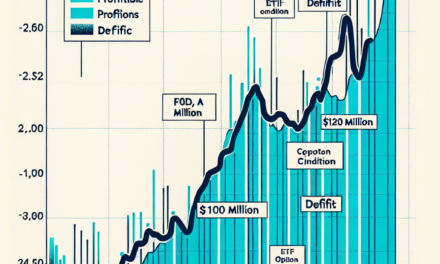“Markets Wrap: Stocks Slide as Fed Rate Hikes Loom and Pound Stumbles.”
Introduction
In today’s market wrap, stocks experienced a decline as investors reacted to shifting expectations regarding Federal Reserve interest rate policies. Concerns over potential rate hikes have led to increased volatility, impacting investor sentiment and contributing to a broader sell-off in equities. Additionally, the British pound faced pressure, weakening against major currencies amid economic uncertainties and ongoing geopolitical tensions. This combination of factors has created a challenging environment for traders, prompting a reevaluation of risk and investment strategies.
Market Overview: Stocks Decline Amid Fed Rate Concerns
In recent trading sessions, stock markets have experienced a notable decline, primarily driven by heightened concerns regarding the Federal Reserve’s interest rate policies. As investors grapple with the implications of potential rate hikes, market sentiment has turned cautious, leading to a sell-off in equities. The prevailing uncertainty surrounding the Fed’s next moves has prompted traders to reassess their positions, resulting in a downward trajectory for major stock indices.
The Federal Reserve’s commitment to combating inflation has been a focal point for market participants. As inflationary pressures persist, the central bank’s stance on interest rates remains a critical factor influencing market dynamics. Recent economic data has suggested that inflation may not be easing as quickly as anticipated, prompting speculation that the Fed may need to maintain or even increase rates for a longer period. This prospect has led to increased volatility in the stock market, as investors weigh the potential impact of tighter monetary policy on corporate earnings and economic growth.
Moreover, the uncertainty surrounding the Fed’s actions has been compounded by mixed signals from various economic indicators. While some reports indicate resilience in consumer spending and job growth, others highlight weaknesses in manufacturing and housing sectors. This divergence in data has left investors uncertain about the overall health of the economy, further contributing to the downward pressure on stocks. As a result, many market participants are adopting a more defensive posture, favoring sectors that are less sensitive to interest rate fluctuations.
In addition to the Fed’s influence, the weakening of the British pound has also played a role in shaping market sentiment. The currency’s decline has raised concerns about the economic outlook for the United Kingdom, particularly in light of ongoing geopolitical tensions and domestic challenges. As the pound weakens, it can lead to increased import costs, which may exacerbate inflationary pressures and complicate the Bank of England’s monetary policy decisions. This situation has not only affected UK markets but has also reverberated across global markets, as investors reassess their exposure to currencies and economies that may be vulnerable to external shocks.
As stocks continue to decline, analysts are closely monitoring the evolving landscape for signs of stabilization. The upcoming economic data releases and Fed communications will be pivotal in shaping market expectations. Investors are particularly keen on any indications from Fed officials regarding their assessment of inflation and the potential trajectory of interest rates. Clarity on these issues could either alleviate some of the current market anxieties or exacerbate them, depending on the tone and content of the messages conveyed.
In conclusion, the recent downturn in stock markets can be attributed to a confluence of factors, primarily centered around the Federal Reserve’s interest rate policies and the weakening of the pound. As investors navigate this complex environment, the interplay between economic data, central bank communications, and geopolitical developments will remain crucial in determining market direction. With uncertainty prevailing, market participants are likely to remain vigilant, adjusting their strategies in response to the evolving economic landscape. The coming weeks will be critical in assessing whether the current trends will persist or if a recovery is on the horizon, as the interplay of these factors continues to shape investor sentiment and market performance.
Impact of Federal Reserve Rate Expectations on Stock Markets
In recent weeks, the stock markets have experienced notable fluctuations, primarily driven by shifting expectations surrounding Federal Reserve interest rate policies. As investors grapple with the implications of potential rate hikes, the overall sentiment in the equity markets has turned cautious. The anticipation of tighter monetary policy has led to increased volatility, as market participants reassess their positions in light of the Fed’s signals regarding inflation and economic growth.
The Federal Reserve’s dual mandate of promoting maximum employment and stable prices often places it at the center of market dynamics. When the Fed indicates a willingness to raise interest rates, it typically reflects concerns about rising inflation or an overheating economy. Consequently, higher interest rates can lead to increased borrowing costs for consumers and businesses alike, which in turn may dampen economic activity. As a result, investors often react by selling off stocks, particularly those in sectors sensitive to interest rate changes, such as technology and consumer discretionary.
Moreover, the relationship between interest rates and stock valuations is critical to understanding market movements. When rates rise, the present value of future cash flows diminishes, leading to lower valuations for growth-oriented companies. This phenomenon has been particularly evident in recent trading sessions, where high-flying tech stocks have faced significant pressure. Investors are increasingly weighing the potential for reduced earnings growth against the backdrop of a tightening monetary policy, prompting a reevaluation of risk appetites across the board.
In addition to the direct impact on stock prices, the Fed’s rate expectations also influence investor sentiment and market psychology. As uncertainty looms regarding the timing and magnitude of rate hikes, traders often adopt a more defensive posture, leading to a flight to safety. This behavior can manifest in increased demand for bonds, particularly U.S. Treasuries, which are perceived as lower-risk investments during periods of market turbulence. Consequently, the yield on government bonds tends to rise in anticipation of rate increases, further complicating the landscape for equities.
Furthermore, the global interconnectedness of financial markets means that U.S. rate expectations can have far-reaching implications beyond domestic borders. For instance, as the Fed signals its intent to tighten monetary policy, emerging markets may experience capital outflows as investors seek higher returns in the U.S. This shift can lead to currency depreciation and increased borrowing costs for countries reliant on foreign investment, thereby exacerbating economic challenges in those regions. The recent weakening of the British pound serves as a case in point, as the currency has come under pressure amid concerns about the Bank of England’s response to similar inflationary pressures.
In conclusion, the interplay between Federal Reserve rate expectations and stock market performance is a complex and multifaceted relationship. As investors navigate this landscape, they must remain vigilant to the evolving economic indicators and central bank communications that shape market sentiment. The current environment underscores the importance of understanding how monetary policy influences not only domestic equities but also global financial markets. As the Fed continues to assess its approach to interest rates, market participants will undoubtedly remain attuned to the implications for both stock valuations and broader economic conditions.
Analyzing the Weakening Pound: Causes and Consequences
The recent decline of the British pound has raised significant concerns among economists and investors alike, prompting a closer examination of the underlying causes and potential consequences of this trend. One of the primary factors contributing to the weakening of the pound is the shifting landscape of monetary policy, particularly in relation to the actions of the Bank of England. As inflationary pressures continue to mount, the central bank faces the challenging task of balancing economic growth with the need to control rising prices. This delicate balancing act has led to uncertainty regarding future interest rate hikes, which in turn has influenced investor sentiment and currency valuation.
Moreover, the broader economic context cannot be overlooked. The United Kingdom has been grappling with a series of economic challenges, including sluggish growth rates and persistent inflation. These issues have been exacerbated by external factors such as geopolitical tensions and supply chain disruptions, which have further strained the economy. As a result, the pound has come under pressure, reflecting a lack of confidence among investors regarding the UK’s economic outlook. This sentiment is particularly pronounced in comparison to other major currencies, where stronger economic indicators have bolstered their respective values.
In addition to these economic factors, political uncertainty has also played a crucial role in the pound’s decline. The ongoing debates surrounding Brexit and its long-term implications for trade and investment have left many investors wary. The lack of a clear and stable political environment can lead to volatility in currency markets, as traders react to news and developments that may impact the UK’s economic stability. Consequently, the pound’s depreciation can be seen as a reflection of both economic fundamentals and political dynamics, creating a complex interplay that influences market behavior.
The consequences of a weakening pound are multifaceted and can have far-reaching implications for the UK economy. For consumers, a depreciated currency often translates to higher import costs, which can exacerbate inflationary pressures. As the cost of imported goods rises, households may find their purchasing power diminished, leading to reduced consumer spending. This decline in consumption can further hinder economic growth, creating a feedback loop that complicates the Bank of England’s efforts to stabilize the economy.
On the other hand, a weaker pound can provide some benefits to certain sectors, particularly exporters. A depreciated currency can make UK goods and services more competitive in international markets, potentially boosting export volumes. However, this advantage may be offset by the rising costs of imported raw materials and components, which can squeeze profit margins for businesses reliant on global supply chains. Thus, while some sectors may benefit from a weaker pound, the overall economic impact remains uncertain and could vary significantly across different industries.
In conclusion, the weakening of the pound is a complex phenomenon driven by a combination of monetary policy uncertainties, economic challenges, and political dynamics. As the situation evolves, it is essential for investors and policymakers to remain vigilant and responsive to the changing landscape. The interplay of these factors will continue to shape the trajectory of the pound and the broader UK economy, underscoring the importance of careful analysis and strategic decision-making in navigating these turbulent waters.
Sector Performance: Which Stocks Are Most Affected?
In the current market landscape, the interplay between Federal Reserve rate expectations and currency fluctuations has significantly influenced sector performance, leading to notable declines in stock prices across various industries. As investors grapple with the implications of potential interest rate hikes, certain sectors have emerged as particularly vulnerable to these economic shifts. The financial sector, for instance, has been under considerable pressure as rising rates typically lead to increased borrowing costs, which can dampen consumer spending and slow economic growth. Consequently, banks and financial institutions have seen their stock prices decline, reflecting investor concerns about future profitability in a higher-rate environment.
Moreover, the technology sector, often characterized by high growth potential, has also felt the brunt of these market dynamics. Investors tend to favor companies with stable earnings in uncertain economic climates, leading to a sell-off in tech stocks that are perceived as riskier. As interest rates rise, the present value of future cash flows diminishes, making growth-oriented tech companies less attractive. This shift in sentiment has resulted in a marked decrease in stock prices for many leading technology firms, which had previously enjoyed robust valuations.
In addition to financials and technology, the consumer discretionary sector has also been adversely affected. As the Fed signals a tightening monetary policy, consumer confidence may wane, leading to reduced spending on non-essential goods and services. Retailers, particularly those reliant on discretionary spending, have seen their stock prices decline as investors anticipate a slowdown in sales growth. This trend is further exacerbated by the weakening of the British pound, which has implications for companies with significant international exposure. A weaker pound can lead to increased costs for imported goods, thereby squeezing profit margins for retailers and manufacturers alike.
Conversely, the energy sector has displayed a degree of resilience amid these market fluctuations. With ongoing geopolitical tensions and supply chain disruptions, energy prices have remained elevated, providing a buffer for companies within this sector. However, even energy stocks are not entirely immune to the broader market trends, as rising interest rates can lead to increased operational costs and affect capital expenditure decisions. Thus, while some energy companies may benefit from high commodity prices, the overall sector remains susceptible to the prevailing economic climate.
Furthermore, the healthcare sector has shown mixed performance in light of these developments. On one hand, healthcare stocks are often viewed as defensive investments, providing stability during economic downturns. On the other hand, concerns about regulatory changes and potential cuts to healthcare spending can weigh heavily on investor sentiment. As a result, while some healthcare companies have managed to maintain their stock prices, others have experienced declines as the market reacts to shifting policy landscapes.
In summary, the current market environment, shaped by Federal Reserve rate expectations and currency fluctuations, has led to a pronounced impact on various sectors. The financial and technology sectors have faced significant challenges, while consumer discretionary stocks have also been adversely affected by changing consumer behavior. Meanwhile, the energy sector has shown resilience, albeit with caution, and the healthcare sector remains a mixed bag. As investors continue to navigate these turbulent waters, the performance of individual stocks will likely remain closely tied to broader economic indicators and policy decisions.
Investor Sentiment: Navigating Uncertainty in the Markets
Investor sentiment plays a crucial role in shaping market dynamics, particularly during periods of uncertainty. As economic indicators fluctuate and geopolitical tensions rise, investors often find themselves grappling with a complex web of information that influences their decision-making processes. Recently, the prevailing mood in the markets has been one of caution, as concerns surrounding Federal Reserve interest rate expectations have begun to weigh heavily on stock performance. This shift in sentiment is not merely a reflection of economic data; it encapsulates a broader apprehension about the future trajectory of monetary policy and its implications for growth.
The Federal Reserve’s stance on interest rates has historically been a significant driver of market behavior. As investors attempt to gauge the central bank’s next moves, they often react to hints and signals from policymakers. In recent weeks, the Fed’s indications of a potentially prolonged period of elevated interest rates have led to increased volatility in equity markets. This uncertainty has prompted many investors to reassess their portfolios, leading to a sell-off in stocks as they seek to mitigate risk. Consequently, the decline in stock prices reflects a broader sentiment of unease, as market participants weigh the potential impact of higher borrowing costs on corporate earnings and economic expansion.
Moreover, the weakening of the British pound has added another layer of complexity to the current market landscape. Currency fluctuations can significantly influence investor sentiment, particularly for those with international exposure. As the pound depreciates, concerns about the UK economy’s resilience come to the forefront, prompting investors to reconsider their positions in British assets. This situation is further exacerbated by the interconnectedness of global markets, where shifts in one region can reverberate across others. As a result, the decline of the pound has not only affected UK-based stocks but has also contributed to a more cautious outlook among global investors.
In navigating this uncertainty, many market participants are turning to alternative strategies to safeguard their investments. Diversification remains a key principle, as investors seek to spread their risk across various asset classes. Additionally, some are gravitating towards defensive sectors, such as utilities and consumer staples, which tend to be more resilient during economic downturns. This shift in focus underscores a broader trend of risk aversion, as investors prioritize stability over potential high returns in a volatile environment.
Furthermore, the current climate has prompted a renewed interest in fixed-income securities, as rising interest rates may offer more attractive yields compared to equities. Bonds, traditionally viewed as a safer investment, are becoming increasingly appealing as investors seek to balance their portfolios amid stock market fluctuations. This pivot towards fixed income reflects a strategic response to the prevailing sentiment, as investors aim to navigate the complexities of the current economic landscape.
In conclusion, investor sentiment is a powerful force that shapes market behavior, particularly in times of uncertainty. The recent decline in stocks, driven by concerns over Federal Reserve rate expectations and the weakening pound, highlights the intricate interplay between economic indicators and investor psychology. As market participants grapple with these challenges, strategies such as diversification and a focus on defensive sectors are becoming more prevalent. Ultimately, the ability to adapt to changing conditions will be crucial for investors seeking to navigate the complexities of the current market environment.
Global Economic Factors Influencing U.S. Markets
In recent weeks, global economic factors have significantly influenced U.S. markets, leading to notable fluctuations in stock prices and currency values. One of the primary drivers of this volatility has been the shifting expectations surrounding Federal Reserve interest rate policies. As investors closely monitor economic indicators, the anticipation of potential rate hikes has created a ripple effect across various sectors. The Fed’s commitment to controlling inflation has led to speculation about the timing and magnitude of future rate increases, which in turn has prompted market participants to reassess their investment strategies.
Moreover, the interplay between domestic economic data and international developments has further complicated the landscape. For instance, recent reports indicating stronger-than-expected job growth and consumer spending in the U.S. have raised concerns about persistent inflationary pressures. Consequently, this has fueled expectations that the Federal Reserve may adopt a more aggressive stance in its monetary policy, thereby impacting stock valuations. As a result, many investors have adopted a cautious approach, leading to a decline in stock prices as they weigh the potential implications of higher borrowing costs on corporate earnings.
In addition to domestic factors, global economic conditions have also played a crucial role in shaping market sentiment. The ongoing geopolitical tensions, particularly in Europe and Asia, have contributed to uncertainty in the financial markets. For instance, developments related to trade agreements, sanctions, and military conflicts can create ripple effects that extend beyond their immediate regions, influencing investor confidence and market stability. As such, U.S. markets have been sensitive to these global dynamics, with fluctuations in stock prices often reflecting broader concerns about economic growth and stability.
Furthermore, the performance of foreign currencies has also impacted U.S. markets, particularly the recent weakening of the British pound. The depreciation of the pound can have significant implications for multinational corporations with exposure to the UK market. As the pound loses value, U.S. companies that rely on exports to the UK may face challenges in maintaining their profit margins. This situation can lead to a reassessment of earnings forecasts, prompting investors to adjust their positions accordingly. Consequently, the decline in the pound has added another layer of complexity to the already intricate relationship between global economic factors and U.S. market performance.
As investors navigate this multifaceted environment, it is essential to recognize the interconnectedness of global economies. The actions of central banks, trade policies, and geopolitical events can create a domino effect that influences market dynamics across borders. For instance, a decision by the European Central Bank to alter its interest rate policy can have implications for U.S. markets, as capital flows and investor sentiment are often swayed by relative economic conditions. Therefore, understanding these global economic factors is crucial for investors seeking to make informed decisions in an increasingly interconnected world.
In conclusion, the current landscape of U.S. markets is heavily influenced by a myriad of global economic factors, including Federal Reserve rate expectations, geopolitical tensions, and currency fluctuations. As these elements continue to evolve, market participants must remain vigilant and adaptable, recognizing that the interplay between domestic and international developments will shape the trajectory of stock prices and overall market performance.
Strategies for Investors in a Volatile Market Environment
In the current landscape of financial markets, characterized by heightened volatility and uncertainty, investors are faced with the challenge of navigating an environment influenced by fluctuating interest rates and currency valuations. As the Federal Reserve continues to signal potential rate hikes, the implications for stock prices and overall market sentiment become increasingly pronounced. Consequently, it is essential for investors to adopt strategies that not only mitigate risk but also capitalize on potential opportunities that arise during turbulent times.
One effective approach is to diversify investment portfolios across various asset classes. By spreading investments among equities, fixed income, commodities, and alternative assets, investors can reduce their exposure to any single market segment. This diversification helps cushion against sharp declines in specific sectors, particularly when economic indicators suggest a slowdown or when central banks adjust monetary policy. For instance, while stocks may experience downward pressure due to rising interest rates, bonds or commodities like gold may provide a hedge against inflation and currency fluctuations, thereby stabilizing overall portfolio performance.
Moreover, maintaining a focus on quality investments is crucial in a volatile market. Investors should prioritize companies with strong balance sheets, consistent cash flow, and robust competitive advantages. These firms are often better positioned to weather economic downturns and can provide more reliable returns over time. In addition, dividend-paying stocks can serve as a source of income during periods of market instability, offering a buffer against price declines. By concentrating on high-quality assets, investors can enhance their chances of achieving long-term growth while minimizing the risks associated with market fluctuations.
Another strategy worth considering is the implementation of a tactical asset allocation approach. This involves actively adjusting portfolio allocations in response to changing market conditions and economic indicators. For instance, if the outlook for equities appears bleak due to rising interest rates, reallocating a portion of the portfolio into defensive sectors such as utilities or consumer staples may provide more stability. Conversely, if market sentiment shifts favorably, increasing exposure to growth-oriented sectors could yield significant returns. This flexibility allows investors to respond proactively to market dynamics, rather than adhering rigidly to a predetermined investment strategy.
In addition to these strategies, investors should also consider employing risk management techniques, such as setting stop-loss orders or utilizing options for hedging purposes. By establishing predetermined exit points, investors can limit potential losses and protect their capital during periods of heightened volatility. Furthermore, options can provide a means to hedge against adverse price movements while allowing for participation in potential upside. These risk management tools are particularly valuable in uncertain environments, where swift market movements can lead to significant financial repercussions.
Lastly, maintaining a long-term perspective is essential for investors navigating a volatile market. While short-term fluctuations can be disconcerting, history has shown that markets tend to recover over time. By focusing on long-term goals and resisting the urge to react impulsively to market noise, investors can better position themselves for future growth. This disciplined approach, combined with a well-thought-out investment strategy, can help investors weather the storms of volatility and emerge stronger in the long run.
In conclusion, while the current market environment presents challenges, it also offers opportunities for those who are prepared. By diversifying portfolios, focusing on quality investments, employing tactical asset allocation, utilizing risk management techniques, and maintaining a long-term perspective, investors can navigate the complexities of a volatile market with greater confidence and resilience.
Q&A
1. **Question:** What caused stocks to fall in the recent market wrap?
**Answer:** Stocks fell due to rising expectations of interest rate hikes by the Federal Reserve.
2. **Question:** How did the Federal Reserve’s stance impact investor sentiment?
**Answer:** The Fed’s indication of potential rate increases led to concerns about higher borrowing costs, negatively affecting investor sentiment.
3. **Question:** What was the performance of major stock indices during this period?
**Answer:** Major stock indices experienced declines, reflecting the overall negative market sentiment.
4. **Question:** How did the British pound perform in the market wrap?
**Answer:** The British pound weakened against other currencies, contributing to concerns about the UK economy.
5. **Question:** What economic indicators influenced the Fed’s rate expectations?
**Answer:** Strong economic data, including employment figures and inflation rates, influenced the Fed’s rate expectations.
6. **Question:** What sectors were most affected by the stock market decline?
**Answer:** Interest-sensitive sectors, such as real estate and utilities, were most affected by the stock market decline.
7. **Question:** What are analysts predicting for future market movements based on current trends?
**Answer:** Analysts predict continued volatility in the markets as investors adjust to changing Fed rate expectations and economic conditions.
Conclusion
In conclusion, the recent market wrap indicates a decline in stock prices driven by heightened expectations of Federal Reserve interest rate hikes, which have created uncertainty among investors. Additionally, the weakening of the British pound further contributed to market volatility, reflecting broader economic concerns. Overall, these factors suggest a cautious outlook for the markets as participants navigate the implications of monetary policy and currency fluctuations.





